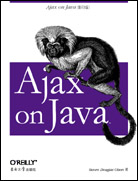
Ajax on Java(影印版)
出版时间:2007年07月
页数:211
《Ajax on Java》展示了如何通过引入新的Ajax功能包括建议列表、拖放等,使你的Java Web应用程序变得更加丰富多彩。该书列举出多种使用Ajax的不同方式,从“手动”将JavaScript构建到你的应用程序,到利用最新的Google Web Toolkit(GWT)等。当然,你还将从中学会怎样在Struts、JSP和JSF应用程序里使用Ajax。
《Ajax on Java》从介绍Ajax开始,教给你如何编写一些基本应用程序,如使用客户端JavaScript程序来向Java servlet请求信息且无需重新加载整个页面便可显示返回结果等。它还展现了若干种客户端与服务器端之间的通信策略,包括发送原始数据以及使用XML或JSON(JavaScript Object Notation)发送更复杂的数据集合。
本书分为若干章节,讲述引入Ajax的不同方法。这些方法包括:
*Prototype和script.aculo.us JavaScript开发库、Dojo和Rico开发库以及DWR
*使用Ajax编写输入表单和建议栏
*创建一个Ajax标记库以及第三方标记库
*将Ajax集成到Java Server Pages(JSP)应用程序
*并用Ajax与Struts
*将Ajax集成到Java Server Faces(JSF)应用程序
*利用Google的GWT所提供的纯Java方法来开发Web应用程序:你的客户端组件用Java编写,然后将其编译为HTML和JavaScript
《Ajax on Java》教你如何构建更为交互、动态、振奋人心和让用户感到愉悦的应用程序。如果你是一位Java开发人员但尚未尝试Ajax而你又愿意现在就开始,那么本书正是你的理想读物。你的用户将会因此而感到高兴。
Steven Douglas Olson从事软件开发已经20余年,自Fortran、Pascal、Basic语言起步,而后在Signetics公司进行C语言开发工作。当就职于Novell时,他开始沉浸于Java语言。1995年,他成为Novell公司Java开发部门的第一批人员之一。迄今为止,他已先后在其他8家公司担任过技术顾问或专职开发人员,主要以Java为开发语言。目前,他在盐湖城从事技术顾问工作。
《Ajax on Java》从介绍Ajax开始,教给你如何编写一些基本应用程序,如使用客户端JavaScript程序来向Java servlet请求信息且无需重新加载整个页面便可显示返回结果等。它还展现了若干种客户端与服务器端之间的通信策略,包括发送原始数据以及使用XML或JSON(JavaScript Object Notation)发送更复杂的数据集合。
本书分为若干章节,讲述引入Ajax的不同方法。这些方法包括:
*Prototype和script.aculo.us JavaScript开发库、Dojo和Rico开发库以及DWR
*使用Ajax编写输入表单和建议栏
*创建一个Ajax标记库以及第三方标记库
*将Ajax集成到Java Server Pages(JSP)应用程序
*并用Ajax与Struts
*将Ajax集成到Java Server Faces(JSF)应用程序
*利用Google的GWT所提供的纯Java方法来开发Web应用程序:你的客户端组件用Java编写,然后将其编译为HTML和JavaScript
《Ajax on Java》教你如何构建更为交互、动态、振奋人心和让用户感到愉悦的应用程序。如果你是一位Java开发人员但尚未尝试Ajax而你又愿意现在就开始,那么本书正是你的理想读物。你的用户将会因此而感到高兴。
Steven Douglas Olson从事软件开发已经20余年,自Fortran、Pascal、Basic语言起步,而后在Signetics公司进行C语言开发工作。当就职于Novell时,他开始沉浸于Java语言。1995年,他成为Novell公司Java开发部门的第一批人员之一。迄今为止,他已先后在其他8家公司担任过技术顾问或专职开发人员,主要以Java为开发语言。目前,他在盐湖城从事技术顾问工作。
- Preface
- 1. Setup
- Requirements
- Installing Tomcat
- Installing Ant
- 2. JavaScript for Ajax
- Creating the Application
- Running the Example
- 3. A Simple Ajax Servlet
- Building and Deploying the Ajax Application
- Running the Example
- 4. XML and JSON for Ajax
- The Character Decoder
- Setting Up a Simple XML Document
- Back on the Client: Mining the XML
- Building the Application
- Running the Application on Tomcat
- Passing Data with JSON
- Summary
- 5. Getting Useful Data
- Form Entry with Ajax
- Building a Suggestion Field
- 6. Ajax Libraries and Toolkits
- Using the Dojo Toolkit
- Using the Rico Toolkit
- Using DWR with Ajax
- Drag ’n’ Drop with Scriptaculous and Prototype
- 7. Ajax Tags
- Creating a Third-Party Tag Libraries
- 8. Ajax on Struts
- Struts-Layout
- Adding Ajax to Struts with DWR
- Ajax with Struts: What Have We Learned Here?
- 9. JavaServer Faces and Ajax
- The JSF Lifecycle
- Writing a Custom JSF Component
- Developing a Custom JSF Tag
- Handling JSF Input by Extending HtmlInputText
- Writing the JSF Support for Ajax
- Summary
- 10. Google Web Toolkit
- Getting Started with GWT
- Debugging the Application
- Fleshing Out the Application: The Client
- Supplying Services to the Client
- Testing ZipCodes with the Service
- GWT Widgets
- Index
书名:Ajax on Java(影印版)
作者:Steven Douglas Olson 著
国内出版社:东南大学出版社
出版时间:2007年07月
页数:211
书号:978-7-5641-0771-0
原版书出版商:O'Reilly Media
The animal on the cover of Ajax on Java is a cotton-top tamarin (Saguinus oedipus), a small-bodied monkey characterized by the fan of long, white hair on its head. Tamarins are divided into three groups based on facial hair. The cotton-top is marked by thin hair on its black-skinned face such that its face appears naked. This puts it squarely into the bare-face group, as opposed to the hairy-face or mottled-face group. Tamarins have claw-like nails resembling those of a squirrel rather than flat
nails like other primates, which they use to cling, run, and leap through trees. They can do this with great ease due to their size: cotton-tops weigh less than one pound and reach only nine inches in height.
Cotton-top tamarins are found in a small area of northwest Colombia. Their range is bound by the Cauca and Magdalena Rivers and the Atlantic coast; however, they are currently found only in parks and reserves throughout this area. A group of tamarins maintains a fixed territory within its home range, which it chooses based on fruit availability. Other sources of nourishment for the tamarin include insects, plant exudates, nectar, and occasionally reptiles and amphibians. Most groups appear to be monogamous, with only one reproductively active male and female. Cotton-tops,like other members of their subfamily (callitrichines), primarily give birth to nonidentical twins. As its scientific name indicates, the male tamarin seems to have an Oedipus complex, yet the mother does not allow this relationship to be consummated.
nails like other primates, which they use to cling, run, and leap through trees. They can do this with great ease due to their size: cotton-tops weigh less than one pound and reach only nine inches in height.
Cotton-top tamarins are found in a small area of northwest Colombia. Their range is bound by the Cauca and Magdalena Rivers and the Atlantic coast; however, they are currently found only in parks and reserves throughout this area. A group of tamarins maintains a fixed territory within its home range, which it chooses based on fruit availability. Other sources of nourishment for the tamarin include insects, plant exudates, nectar, and occasionally reptiles and amphibians. Most groups appear to be monogamous, with only one reproductively active male and female. Cotton-tops,like other members of their subfamily (callitrichines), primarily give birth to nonidentical twins. As its scientific name indicates, the male tamarin seems to have an Oedipus complex, yet the mother does not allow this relationship to be consummated.
购买选项